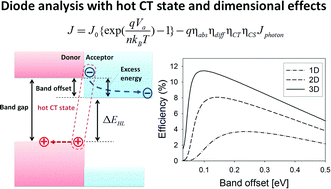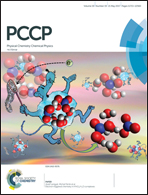A theoretical study on hot charge-transfer states and dimensional effects of organic photocells based on an ideal diode model
Abstract
This paper discusses an ideal diode model with hot charge-transfer (CT) states to analyze the power conversion efficiency of an organic photocell. A free carrier generation mechanism via sunlight in an organic photocell consists of four microscopic processes: photon absorption, exciton dissociation, CT, and charge separation. The hot CT state effect has been actively investigated to understand the charge separation process. We previously reported a theoretical method to calculate the efficiency of the charge separation process via a hot CT state (T. Shimazaki et al., Phys. Chem. Chem. Phys., 2015, 17, 12538 and J. Chem. Phys., 2016, 144, 234906). In this paper, we integrate the simulation method into the ideal photocell diode model and calculate several properties such as short circuit current, open circuit voltage, and power conversion efficiency. Our results highlight that utilizing the dimensional (entropy) effect together with the hot CT state can play an essential role in developing more efficient organic photocell devices.



 Please wait while we load your content...
Please wait while we load your content...